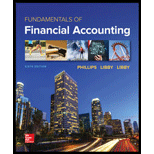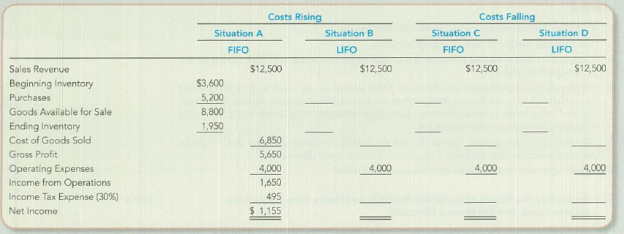
Loose Leaf For Fundamentals Of Financial Accounting
6th Edition
ISBN: 9781260159547
Author: Phillips Associate Professor, Fred, Libby, Robert, Patricia
Publisher: McGraw-Hill Education
expand_more
expand_more
format_list_bulleted
Concept explainers
Textbook Question
Chapter 7, Problem 9E
Choosing LIFO versus FIFO When Costs Are Rising and Falling
Use the following information to complete this exercise: sales, 550 units for 512,500; beginning inventory 300 units; purchases, 400 units; ending inventory, 150 units; and operating expenses, $4,000. Begin by setting up the following table and then complete the requirements that follow.

Required:
- 1. Complete the table for each situation. In Situations A and B (costs rising), assume the following: beginning inventory, 300 units at $12 = $3,600; purchases, 400 units at $13 $5,200. In Situations C and D (costs falling), assume the opposite; that is, beginning inventory, 300 units at $13 = $3,900; purchases, 400 units at $12 = $4,800. Use periodic inventory procedures.
- 2. Describe the relative effects on Income from Operations as demonstrated by requirement 1 when costs are rising and when costs are falling.
- 3. Describe the relative effects on Income Tax Expense for each situation.
Expert Solution & Answer
Want to see the full answer?
Check out a sample textbook solution
Students have asked these similar questions
Can you explain the correct methodology to solve this financial accounting problem?
Can you explain this financial accounting question using accurate calculation methods?
I am looking for help with this financial accounting question using proper accounting standards.
Chapter 7 Solutions
Loose Leaf For Fundamentals Of Financial Accounting
Ch. 7 - What are three goals of inventory management?Ch. 7 - Describe the specific types of inventory reported...Ch. 7 - The chapter discussed four inventory costing...Ch. 7 - Which inventory cost flow method is most similar...Ch. 7 - Where possible, the inventory costing method...Ch. 7 - Contrast the effects of LIFO versus FIFO on ending...Ch. 7 - Contrast the income statement effect of LIFO...Ch. 7 - Several managers in your company are experiencing...Ch. 7 - Explain briefly the application of the LCM rule to...Ch. 7 - Prob. 10Q
Ch. 7 - You work for a made-to-order clothing company,...Ch. 7 - Prob. 12QCh. 7 - (Supplement 7B) Explain why an error in ending...Ch. 7 - Which of the following statements are true...Ch. 7 - The inventory costing method selected by a company...Ch. 7 - Which of the following is not a name for a...Ch. 7 - Which of the following correctly expresses the...Ch. 7 - A New York bridal dress designer that makes...Ch. 7 - If costs are rising, which of the following will...Ch. 7 - Which inventory method provides a better matching...Ch. 7 - Which of the following regarding the lower of cost...Ch. 7 - An increasing inventory turnover ratio a....Ch. 7 - In which of the following situations is an LCM/NRV...Ch. 7 - Matching Inventory Items to Type of Business Match...Ch. 7 - Reporting Goods in Transit Abercrombie Fitch Co....Ch. 7 - Prob. 3MECh. 7 - Reporting Inventory-Related Accounts in the...Ch. 7 - Matching Financial Statement Effects to Inventory...Ch. 7 - Matching Inventory Costing Method Choices to...Ch. 7 - Calculating Cost of Goods Available for Sale,...Ch. 7 - Calculating Cost of Goods Available for Sale,...Ch. 7 - Calculating Cost of Goods Available for Sale,...Ch. 7 - Prob. 10MECh. 7 - Calculating Cost of Goods Available for Sale, Cost...Ch. 7 - Calculating Cost of Goods Available for Sale, Cost...Ch. 7 - Calculating Cost of Goods Available for Sale, Cost...Ch. 7 - Reporting Inventory under Lower of Cost or...Ch. 7 - Preparing the Journal Entry to Record Lower of...Ch. 7 - Determining the Effects of Inventory Management...Ch. 7 - Interpreting LCM Financial Statement Note...Ch. 7 - Calculating the Inventory Turnover Ratio and Days...Ch. 7 - Prob. 19MECh. 7 - Prob. 20MECh. 7 - Prob. 21MECh. 7 - (Supplement 7A) Calculating Cost of Goods Sold and...Ch. 7 - (Supplement 7B) Determining the Financial...Ch. 7 - Prob. 24MECh. 7 - Reporting Goods in Transit and Consignment...Ch. 7 - Determining the Correct Inventory Balance Seemore...Ch. 7 - Determining the Correct Inventory Balance Seemore...Ch. 7 - Calculating Cost of Ending Inventory and Cost of...Ch. 7 - Calculating Cost of Ending Inventory and Cost of...Ch. 7 - Prob. 6ECh. 7 - Analyzing and Interpreting the Financial Statement...Ch. 7 - Evaluating the Effects of Inventory Methods on...Ch. 7 - Choosing LIFO versus FIFO When Costs Are Rising...Ch. 7 - Using FIFO for Multiproduct Inventory Transactions...Ch. 7 - Reporting Inventory at Lower of Cost or Market/Net...Ch. 7 - Reporting Inventory at Lower of Cost or Market/Net...Ch. 7 - Analyzing and Interpreting the Inventory Turnover...Ch. 7 - Analyzing and Interpreting the Effects of the...Ch. 7 - Prob. 15ECh. 7 - Analyzing and Interpreting the Financial Statement...Ch. 7 - Prob. 17ECh. 7 - Analyzing the Effects of Four Alternative...Ch. 7 - Evaluating the Income Statement and Income Tax...Ch. 7 - Calculating and Interpreting the Inventory...Ch. 7 - Prob. 4CPCh. 7 - (Supplement 7B) Analyzing and Interpreting the...Ch. 7 - Analyzing the Effects of Four Alternative...Ch. 7 - Evaluating the Income Statement and Income Tax...Ch. 7 - Prob. 3PACh. 7 - Prob. 4PACh. 7 - (Supplement 7B) Analyzing and Interpreting the...Ch. 7 - Prob. 1PBCh. 7 - Prob. 2PBCh. 7 - Prob. 3PBCh. 7 - Prob. 4PBCh. 7 - (Supplement 7B) Analyzing and Interpreting the...Ch. 7 - Prob. 1COPCh. 7 - (Supplement 7A) Recording Inventory Transactions,...Ch. 7 - (Supplement 7A) Recording Inventory Purchases,...Ch. 7 - (Supplement 7A) Recording Inventory Purchases,...Ch. 7 - Prob. 5COPCh. 7 - Prob. 6COPCh. 7 - Prob. 7COPCh. 7 - Prob. 8COPCh. 7 - Prob. 9COPCh. 7 - Prob. 10COPCh. 7 - Prob. 11COPCh. 7 - Prob. 12COPCh. 7 - Prob. 1SDCCh. 7 - Prob. 2SDCCh. 7 - Critical Thinking: Income Manipulation under the...Ch. 7 - Accounting for Changing Inventory Costs In...
Knowledge Booster
Learn more about
Need a deep-dive on the concept behind this application? Look no further. Learn more about this topic, accounting and related others by exploring similar questions and additional content below.Similar questions
- I am looking for help with this general accounting question using proper accounting standards.arrow_forwardPlease provide the correct answer to this financial accounting problem using accurate calculations.arrow_forwardI am searching for the right answer to this financial accounting question using proper techniques.arrow_forward
- Please help me solve this financial accounting question using the right financial principles.arrow_forwardCan you solve this financial accounting problem with appropriate steps and explanations?arrow_forwardCan you show me the correct approach to solve this financial accounting problem using suitable standards?arrow_forward
- I am looking for help with this general accounting question using proper accounting standards.arrow_forwardI need assistance with this financial accounting problem using valid financial procedures.arrow_forwardPlease provide the correct answer to this general accounting problem using accurate calculations.arrow_forward
- Please provide the correct answer to this general accounting problem using accurate calculations.arrow_forwardI am looking for a step-by-step explanation of this financial accounting problem with correct standards.arrow_forwardCan you solve this general accounting problem with appropriate steps and explanations?arrow_forward
arrow_back_ios
SEE MORE QUESTIONS
arrow_forward_ios
Recommended textbooks for you
- Principles of Accounting Volume 1AccountingISBN:9781947172685Author:OpenStaxPublisher:OpenStax College
 Cornerstones of Financial AccountingAccountingISBN:9781337690881Author:Jay Rich, Jeff JonesPublisher:Cengage Learning
Cornerstones of Financial AccountingAccountingISBN:9781337690881Author:Jay Rich, Jeff JonesPublisher:Cengage Learning  Excel Applications for Accounting PrinciplesAccountingISBN:9781111581565Author:Gaylord N. SmithPublisher:Cengage Learning
Excel Applications for Accounting PrinciplesAccountingISBN:9781111581565Author:Gaylord N. SmithPublisher:Cengage Learning

Principles of Accounting Volume 1
Accounting
ISBN:9781947172685
Author:OpenStax
Publisher:OpenStax College

Cornerstones of Financial Accounting
Accounting
ISBN:9781337690881
Author:Jay Rich, Jeff Jones
Publisher:Cengage Learning


Excel Applications for Accounting Principles
Accounting
ISBN:9781111581565
Author:Gaylord N. Smith
Publisher:Cengage Learning
Chapter 6 Merchandise Inventory; Author: Vicki Stewart;https://www.youtube.com/watch?v=DnrcQLD2yKU;License: Standard YouTube License, CC-BY
Accounting for Merchandising Operations Recording Purchases of Merchandise; Author: Socrat Ghadban;https://www.youtube.com/watch?v=iQp5UoYpG20;License: Standard Youtube License